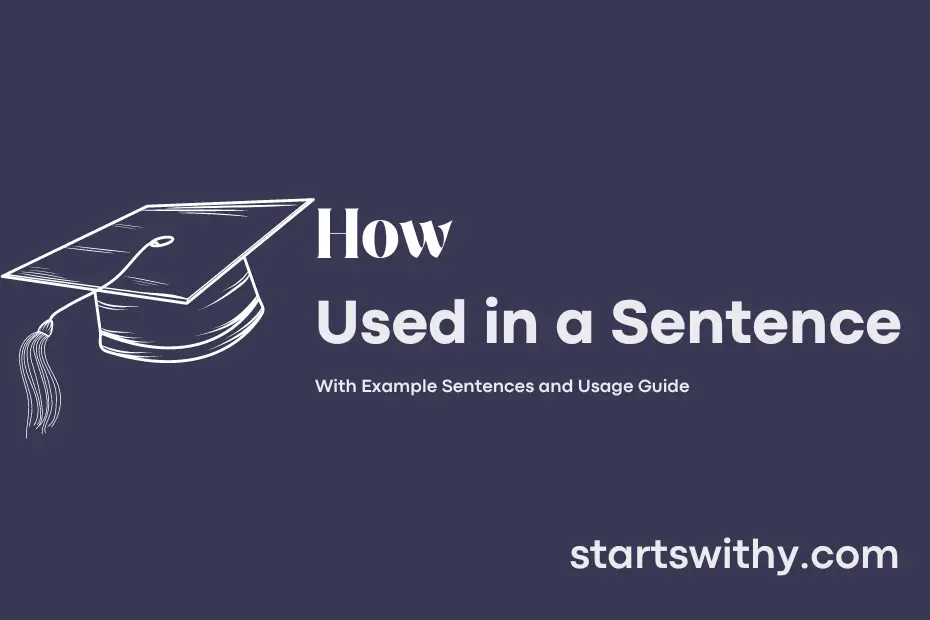Curious about how to use “how” in example sentences? “How” is an interrogative adverb that is commonly used to ask about manner, method, or condition. It can also introduce indirect questions and express surprise or disbelief. When crafting sentences with “how,” consider the context in which it is being used to ensure clarity and coherence in your communication. Whether you’re seeking information, expressing wonder, or providing instructions, the versatile nature of “how” can add depth and inquiry to your writing.
7 Examples Of How Used In a Sentence For Kids
- How are you feeling today?
- Can you show me how to draw a circle?
- How many fingers do you have?
- Do you know how to say “thank you” in Hindi?
- How do you tie your shoelaces?
- How does a butterfly fly?
- Can you tell me how many colors are in a rainbow?
14 Sentences with How Examples
- How do I improve my grades in this subject?
- Can you explain how to properly format this essay?
- I don’t understand how to solve this problem in the math assignment.
- How can I manage my time better to balance studying and socializing?
- Do you know how to access online resources for research?
- Can you show me how to set up a study schedule for exams?
- I’m not sure how to approach my professor about an extension on this assignment.
- Could you explain how to cite sources correctly in my research paper?
- How should I prepare for campus placements and interviews?
- Do you know how to join a student club or organization on campus?
- Can you tell me how to apply for scholarships or financial aid?
- How can I volunteer for community service projects while balancing my studies?
- I need advice on how to improve my presentation skills for seminars and workshops.
- Can you suggest how to maintain a healthy lifestyle while dealing with the pressures of college life?
How To Use How in Sentences?
To use “how” in a sentence, follow these simple steps:
-
Identify the context: Before using “how” in a sentence, understand that it is typically used to ask about the way something is done, the manner in which something happens, or the condition or state of something.
-
Ask questions: We often use “how” to form questions. For example, “How are you feeling today?” or “How do you make a paper airplane?” In these instances, “how” is used to inquire about a process or state.
-
Provide answers: When answering a question that includes “how,” ensure that your response provides information about the method or manner in which something is done. For example, “I am feeling great today” or “To make a paper airplane, you fold the paper in half and then create wings at the sides.”
-
Utilize it in statements: In addition to questions, you can also use “how” in statements to express surprise, admiration, or curiosity. For example, “I can’t believe how fast she ran” or “I like how you always stay positive.”
-
Practice: To get comfortable using “how” in sentences, practice constructing different types of questions and statements. This will help you become more fluent in incorporating “how” effectively in your communication.
By following these steps and practicing regularly, you can become proficient in using “how” in sentences to ask questions, provide answers, and express thoughts or observations.
Conclusion
In conclusion, the varied examples of sentences using the keyword “how” showcase its versatility in setting up questions, expressing curiosity, or providing explanations. From inquiring about procedures, asking for information, or illustrating processes, “how” plays a crucial role in forming clear and coherent sentences. It helps to establish a deeper understanding of a topic by prompting explanations and guiding discussions in a concise and easily understandable manner.
By incorporating “how” into sentences, individuals can effectively seek guidance, clarify directions, or articulate their thoughts. Its usage allows for a smoother flow of communication and aids in conveying ideas with precision. Ultimately, the significance of “how” lies in its ability to facilitate conversations, foster understanding, and convey information effectively in various contexts.



